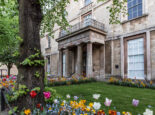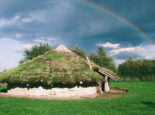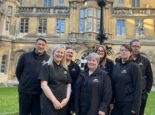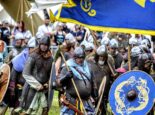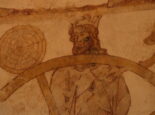A history of Peterborough in six chapters…
[prev] …the rich and giving to the poor, however. Needing men to help fight his cause, Hereward had employed a bunch of Northmen – yes, more Vikings – and in 1170, apparently under Hereward’s leadership, they sacked the cathedral all over again. It was claimed that Hereward did this to deny the Normans the cathedral’s treasures, but the riches didn’t go to the oppressed English. In fact, they were never seen again. The Chronicle states they were taken off in Viking ships to Norway, Denmark and Ireland. ‘Thus,’ it concludes, ‘was the minster of Peterborough burned and plundered.’
Hereward was said to have escaped, but his rebellion – and looting career – was at an end
And Hereward himself? He held out for a time at Ely, in the Fens – the landscape that had nurtured and protected him – but after an unsuccessful attempt by the Normans to intimidate him into surrendering (they hired a witch to curse him from the top of a wooden tower, but Hereward set alight to it) they bribed a monk to reveal a path through the marshes, and so took the town. Hereward was said to have escaped, but his rebellion – and looting career – was at an end.
The Peasants’ Revolt and the Bloody Riot
In 1381, England had been at war with France for 44 years. Taxation was heavy, and all Europe was still suffering from the effects of the Black Death. In late May, poll tax riots sparked revolt, and on 13 June, an army of Kentish peasants marched on London, led by Wat Tyler. Richard II – then only 14 – was forced to flee as the rebels took control of the Tower of London. Rebellion spread like a fire. On 17 June, in Peterborough – then known as Burgh St Peter – a mob laid siege to the abbey, a symbol of wealth and authority that was a convenient focus for their anger. It also housed local tax records, whose destruction might benefit them.
The only chronicler to record what happened next was Henry Knighton, Canon of the Augustinian Priory of St Mary in the Meadows at Leicester. He describes how ‘help came in the shape of lord Henry Despenser, bishop of Norwich, who, through the agency of divine mercy, arrived with a strong force … Some were struck down with swords and spears near the altar and others at the church walls, both inside and outside the building … For the bishop gladly stretched his avenging hand over them and did not scruple to give them final absolution for their sins with his sword…’
Three hundred to 400 people were indiscriminately slaughtered in Cathedral Square that day – among them woman and children. In London, Wat Tyler was already dead, his head stuck on a pole, the rebellion collapsing. The fighting bishop, meanwhile, went on around the region, putting down revolt wherever he found it in similar uncompromising fashion.
The Civil War
In 1642, the city was again divided. Peterborough was nominally Royalist, with Royalist strongholds at Stamford and Crowland – but it was also on the edge of the Eastern Association of counties who were for Parliament.
In 1643 Parliamentarian forces arrived to settle the matter. Their colonel – a former member of Parliament from Huntingdon named Oliver Cromwell – led the army north, routing The Royalists, They took refuge at Burghley House, but were soon captured. Peterborough itself was untouched – with the exception, again, of the poor Cathedral. Cromwell’s men… [cont]








